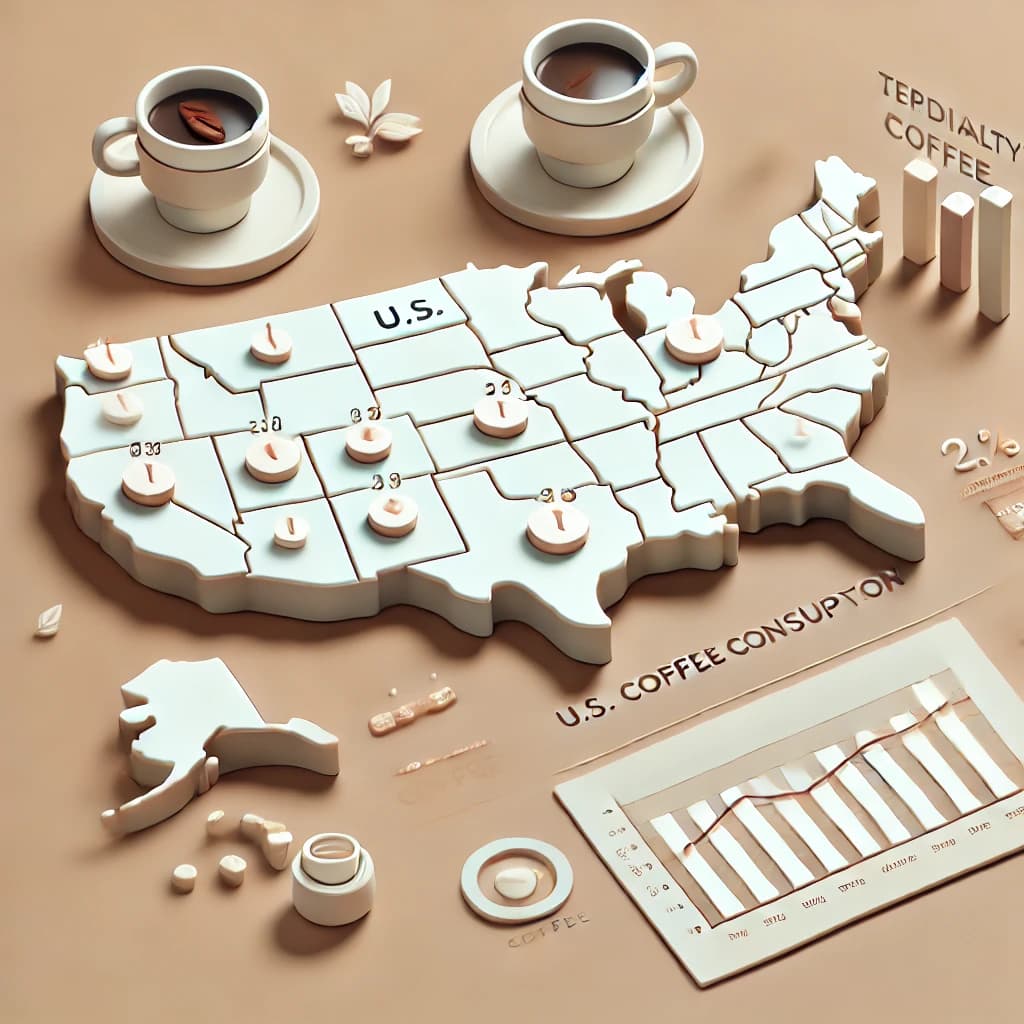The 2024 National Coffee Data Trends (NCDT) Specialty Coffee Report by the National Coffee Association (NCA) provides an in-depth look at the evolving landscape of coffee consumption in the United States, with a particular focus on specialty coffee. The report sheds light on significant trends, consumer demographics, and coffee consumption behaviors, providing a snapshot of how specialty coffee has continued to gain prominence despite economic challenges.
Rising Specialty Coffee Consumption
In January 2024, 45% of American adults reported consuming a specialty coffee in the past day—an all-time high. This represents a 4 percentage point (pp) increase compared to 2023 and an 80% surge since 2011(SRC_2024)(2024 SCR Highlights). This growth is largely driven by the increasing popularity of espresso-based beverages (26%) and non-espresso beverages such as cold brews and frozen blended coffee, which continue to appeal to younger consumers even in winter months(SRC_2024).
Key Consumer Demographics
The report highlights that the strongest penetration of specialty coffee consumption is among individuals aged 25-39, with 66% of this age group consuming specialty coffee in the past week. This demographic is less affected by financial concerns, allowing them to continue indulging in premium coffee beverages(SRC_2024). The next highest consumption rate is seen in the 18-24 age group, with frozen blended coffee being particularly popular with 25% of individuals in this cohort choosing it as their preferred drink(SRC_2024).
Hispanic-Americans stand out as a key ethnic group driving specialty coffee consumption. In January 2024, 69% of Hispanic-American adults consumed specialty coffee in the past week, with a particular preference for espresso-based beverages like café mocha and Caffè Americano(SRC_2024).
The Role of Cultural Trends
The report underscores the influence of cultural and social factors on the rising popularity of specialty coffee, especially among younger consumers. Approximately 75% of past-week specialty coffee drinkers agree that drinking cold brew is perceived as “cool or trendy,” highlighting the role of coffee in contemporary social trends(SRC_2024)(2024 SCR Highlights).
Preparation Methods and In-Home Brewing
In-home coffee preparation remains the dominant method of consumption for most Americans, with 75% of specialty coffee drinkers preparing at least one cup of coffee at home in the past day(SRC_2024). While drip coffee makers (32%) and single-cup brewers (25%) remain the most popular methods, there has been a notable increase in the use of ready-to-drink (RTD) options, which grew by 10 percentage points compared to 2023(SRC_2024).
Interestingly, specialty coffee drinkers are more likely to engage with out-of-home coffee preparation than traditional coffee drinkers. In the past week, 55% of specialty coffee drinkers enjoyed a coffee made outside the home, whether from coffee shops, restaurants, or cafes(SRC_2024).
Specialty Coffee Versus Traditional Coffee
Specialty coffee drinkers, on average, consume more coffee per day than traditional coffee drinkers. In January 2024, past-day specialty coffee drinkers consumed an average of 2.8 cups per day compared to the 1.8 cups per day consumed by traditional coffee drinkers(SRC_2024). This trend points to the stronger engagement of specialty coffee drinkers with premium coffee experiences, even in times of rising inflation(2024 SCR Highlights).
Moreover, 83% of the coffee consumed by specialty coffee drinkers is specialty coffee, reinforcing their loyalty to high-quality, premium beverages(SRC_2024).
Challenges and Resilience Amid Financial Pressures
Despite heightened financial anxieties due to inflation, specialty coffee consumption has remained resilient. Many consumers have shifted their coffee habits to more cost-effective in-home brewing solutions, using espresso machines and slow-drip cold brew makers. However, the increasing demand for premium coffee experiences suggests that consumers are finding ways to balance financial challenges with their passion for coffee(SRC_2024)(2024 SCR Highlights).
Global Influence and Beverage Preferences
The report also touches on Americans’ experiences with global coffee beverages. Specialty coffee drinkers show more adventurous tendencies compared to traditional coffee drinkers, trying a wide range of global coffee drinks such as Arabic coffee, Turkish coffee, and Vietnamese coffee. However, about 40% of specialty coffee drinkers have not yet tried these global options, suggesting an opportunity for further exploration of international coffee culture in the U.S.(SRC_2024)(2024 SCR Highlights).
Conclusion
The 2024 NCDT Specialty Coffee Report provides a comprehensive overview of the growing specialty coffee segment in the United States. The data illustrates how cultural and social factors, driven largely by younger demographics, are shaping the coffee industry. As specialty coffee continues to gain traction, its influence on consumer habits, preparation methods, and beverage choices is poised to keep evolving, solidifying its place as a key driver in the broader coffee market.
Despite the financial challenges many Americans face, the continued demand for specialty coffee signals a deep-rooted connection to the premium coffee experience, making this segment one to watch in the years ahead.


